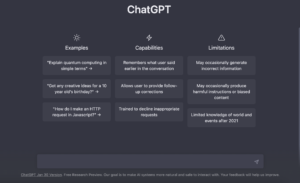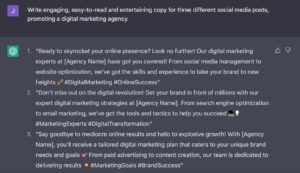Social media has revolutionised the way we interact and share information. The rise of new technologies has further enhanced this experience and has allowed for more creative and personalised content creation. One such technology that is changing the game is ChatGPT.
ChatGPT is a state-of-the-art language model developed by OpenAI. It uses artificial intelligence and machine learning to generate human-like text.
How human-like it really is, though, remains open for debate.

Since social media is mainly text-based, this tool can prove extremely useful for generating post ideas. What’s more, it can even generate the posts themselves.
The tool has been trained on a huge corpus of text data. This includes over 8 million web pages and books – and it continues to learn and evolve as it is exposed to more data.
Whilst ChatGPT is currently available as a ‘Free Preview’, a ‘Plus’ subscription is starting to be rolled out at a cost of USD$20 per month.
This new subscription offers more advanced features, higher usage limits and priority access compared to free users.
ChatGPT is changing the social media content creation and marketing landscape in several ways. Here are some of the ways it is having a significant impact:
1. Content Creation Automation
ChatGPT has made it possible to automate content creation, which can save businesses a considerable amount of time and effort.
With ChatGPT, you can generate high-quality content in minutes, which would have taken hours or even days to produce manually.
This is particularly useful for businesses that need to generate a large amount of content regularly.
2. Personalized Content Generation
ChatGPT also allows for personalised content generation.
This means that you can generate content tailored to specific audiences based on their interests, preferences, and demographics.

However, this only works well if your requests are detailed and specific. As you can see above, we tested out a very niche request. And, whilst the hashtags are a little off, it delivered the copy in exactly the right tone.
When used correctly, this is particularly useful for social media marketing, as content that provides value to your target audience is more likely to lead to higher engagements.
3. Chatbots for Customer Service
There is also functionality for chatbots to be powered by ChatGPT. These would be available 24/7 to answer customer queries and resolve issues in real time.
This tool can help businesses to improve their customer satisfaction and loyalty, as well as reduce support costs.
However, since ChatGPT is in a ‘Free Preview’ stage, we suspect this service may be pretty expensive when it is fully released – and lack a particular human touch.
4. Social Media Marketing Campaigns
ChatGPT can also be used to create and manage social media marketing campaigns.
For example, it can generate ad copy, hashtags, and captions for your social media posts. Plus, if you’re not happy for it to write the whole post, it can give you some relatively detailed and in-depth ideas to work on.

Above, you can see what it told us when we asked it to provide copy for posts promoting a digital marketing agency.
ChatGPT can also be used to analyse and optimise your social media performance.
When asked, it can offer insights into what works and doesn’t and make recommendations for future campaigns.
5. Content Translation and Localisation
People also use ChatGPT for content translation and localisation.
This means you can reach wider audiences and expand your brand’s reach internationally by generating content in multiple languages.
To test this out, we asked ChatGPT to translate the social media copy it gave us into French. And it did just that!
This is particularly useful for businesses that operate in multiple countries, as it enables them to connect with local audiences in their own language.
Are there any downsides to ChatGPT?
While ChatGPT offers some benefits for social media marketing, there are also downsides to consider.
1. Lack of Human Touch
One of the main drawbacks of using ChatGPT for social media content creation is the lack of human touch.
Since understanding your target audience is a necessity to create content that is relevant and valuable, this can be an issue.
Furthermore, ChatGPT-generated content may not always reflect the tone, style, and voice of a brand.
Plus, it may not always be able to capture the essence of a brand’s personality and values.
2. Risk of Miscommunication
Another downside of using ChatGPT is the risk of miscommunication.
ChatGPT produces text that resembles human writing. However, as it lacks a human touch, it may not always understand the context in which it is being used.
This can result in messages that are inappropriate, offensive, or misleading. That’s something that no one would want their brand to be associated with.
3. Dependence on Data
The sources determine the quality of the data used to train ChatGPT, even though ChatGPT trains on a large corpus of text data.
Not all data is perfect. Bias or inaccuracies in the training data can lead to the generation of incorrect or irrelevant content by ChatGPT.
That is why it’s so important to proofread and edit the content that it produces. However, this takes time: you might end up wishing you had written it yourself in the first place.
4. The ethics of replacing humans
BuzzFeed, a popular digital media and news company, is reportedly exploring the use of ChatGPT for content creation.
They are replacing some content creation staff with ChatGPT to streamline processes and reduce costs.
The company is using the tool to generate articles as well as its infamous quizzes. This news came just one month after the company laid off 12% of its workforce.
The ethical concerns surrounding this may be disconcerting to some. Especially since it doesn’t seem that ChatGPT can do as good a job as humans can.
5. Challenges with SEO
Finally, there may be challenges with SEO when using ChatGPT for writing copy. ChatGPT will not optimise its content for search engines all the time.
Also, it is not always able to incorporate the keywords and phrases that are most relevant to your target audience. That means that performing your own keyword research is still necessary.
As such, if you’re looking to grow your presence on TikTok, a platform that is increasingly dependent upon its search engine function, ChatGPT may not be appropriate for your brand.
To conclude…
In conclusion, ChatGPT has the potential to revolutionise the way businesses approach content creation and marketing.
The tool makes it possible to generate high-quality content in minutes, reach a wider audience, and improve customer satisfaction.
However, while ChatGPT offers many benefits for social media content creation and marketing, it is important to be mindful of its potential downsides.
Brands should carefully consider the context in which they are using ChatGPT. It’s important to ensure that they are using it in a way that aligns with their brand values and objectives.
Businesses need to review and edit the content to guarantee accuracy, relevancy, and consistency with their brand voice.
As such, businesses may still find it much more effective to outsource their social media marketing to the experts. Book your free consultation with Little Media Agency here.



